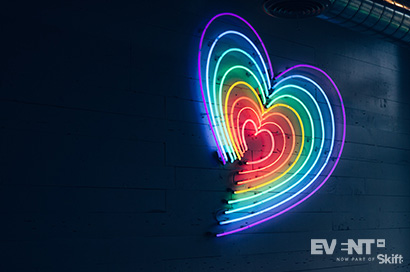Skift Take
While the events industry has made some progress in terms of diversity and inclusion for the LGBTQ+ community, many events lack initiative and many areas are not as progressive. Are events really inclusive? Let's find out.
Over the last few decades, we’ve made great strides when it comes to diversity and inclusion (D&I), and nowhere is this progress more apparent than in the arena of LGBTQ+ rights.
The fact is that the events industry in the US is now a safe space for the LGBTQ community. Organizations seen to exclude anyone based on gender or sexual orientation pay in the court of public opinion, and even areas you once thought might be inhospitable are trying to brand themselves as open and accepting.
But is safety the same as progress when it comes to D&I? Or is it just the most basic prerequisite for any attendee? What does it mean to be diverse and inclusive in 2020?
As recently as 2016, North Carolina’s HB2 (House Bill 2) tried to impose gender-based restrictions on public bathrooms. Now, while it’s by no means widespread, some event planners are making arrangements for gender-neutral washrooms at their venues. But we still don’t see that accommodation everywhere, and it’s rare to see event badging that accounts for how attendees want to be addressed.
Everyone seems to have good intentions, but when it comes to practical applications, many just don’t know how to implement the best practices or find the resources they need.
So where do we go from here?
For an insider’s perspective, we spoke to three top members from the LGBT Meeting Planners Association (LGBT MPA) about two valuable areas for improvement: visibility for the LGBTQ community and advocacy for its members in places where the environment is less progressive.
Here’s what we learned.
Visibility and the Value of Community in Events
Visibility is still an extremely important factor in the progression of any marginalized group. LGBTQ+ attendees and allies may not feel the need to hide, but that doesn’t mean they feel seen. There are benefits to being represented within the industry as a whole and to having the ability to find and identify other members of the LGBTQ+ community for support.
Many of us are aware that the LGBTQ+ community already has a large presence in the event planning industry, but it may surprise some that the first association representing its members in events was founded only four years ago. By comparison, the travel industry’s International Gay and Lesbian Travel Association (IGLTA) was founded in 1983.
We spoke to David Jefferys, its founder and an LGBTQ+ champion with 35 years of experience in destination marketing, to talk about the value of visibility in an atmosphere that is already ostensibly LGBTQ-friendly.
Capturing the Value of Community
Despite the growing numbers (over 1500) and backing from major players like PCMA, MPI, and IMEX, some still question the point of having an LGBT Meeting Planners Association (LGBT MPA) when so many of the community’s battles have already been won.
Jefferys has already witnessed the benefits of this kind of community-building. He founded the organization not so much out of the need to tackle a specific challenge, but more out of a desire to create a resource for people who would otherwise have no professional representation.
For Jefferys and other leaders at the LGBT MPA, it is all about figuring out how to create synergies between business interests and the needs of the community. Sometimes this means being a resource for information on destinations and suppliers that support the LGBTQ+ cause, and sometimes it simply means providing opportunities for networking within the community.
It is all about figuring out how to create synergies between business interests and the needs of the community.
Having a unified representative group creates an entity with a strong voice that can be invited to and facilitate conversations on behalf of the community. It creates visibility of the community for the broader industry at large.
But it also facilitates visibility within the community itself. Members who see others like them will feel more comfortable representing themselves and their interests authentically and less pressured to conceal aspects of their lives for fear of not fitting in. Moreover, the shared membership within a community creates a basis for bonding and support that can improve event experiences themselves (more on that below).
Continued Advocacy
Jefferys is also quick to point out that 23% of its members are planners who organize international events, and it goes without saying that many parts of the world are not as progressive as North America when it comes to LGBTQ+ rights. Navigating this terrain can be a tricky business, and planners need all the resources they can get.
Jim Clapes, events manager at Specialty Food Association and a board member at the LGBT MPA, further emphasizes the need to remain vigilant about where the industry is moving.
Looking forward, technological change could bring new challenges for the LGBTQ+ community. For example, facial recognition technology presents the possibility of misgendering trans individuals, and AI-powered market segmentation runs the risk of perpetuating prejudicial assumptions about marginalized groups. An advocacy group can provide a platform for affected individuals to voice their concerns as well as a resource for anyone who needs guidance on how to be mindful of these issues as they arise.
Make sure that your staff is aware of supports like the LGBT MPA. For those working at larger organizations, it might be time to consider offering in-house community groups if they don’t already exist.
Business Partnerships Shape the D&I Dialogue
In today’s political climate, we are more aware than ever that our purchasing decisions have the power to influence social and regulatory change. We all vote with our dollars, and since travel and event planning go hand in hand, the events industry is in a unique position to sway thinking beyond regional borders.
Advocacy groups understand this reality more than anyone, and they can help to foreground this relationship. The equation works both ways: those with buying power can influence social change through their purchasing decisions, and those courting new business can recognize the economic benefits of adapting to shifting values.
As Clapes explained, it can be particularly effective to leverage the business incentive behind D&I initiatives. As long as there are channels of communication to keep everyone informed about the options available, the organizations and destinations that are more inclusive will inevitably attract a wider clientele.
For example, as part of their mission to facilitate business partnerships that strengthen the LGBTQ+ cause, the LGBT MPA has produced a diverse supplier resource guide for event planners. This directory provides guidance on suppliers with strong ties to the LGBTQ+ community.
Whenever possible, try to do a little research into the D&I history of your prospective suppliers.
D&I Initiatives You Can Take in 2020
Make Diverse Groups Feel Welcome
As simple as it may sound, one of the greatest benefits that comes with a D&I-related association is the sense of community that it generates. The same can be said for smaller initiatives, such as D&I-themed programming at events.
And the LGBTQ+ example can serve as a model for D&I more generally. We are no longer in an era where the concept of equality means erasing or denying differences.
Derrick Johnson, the Executive Director at NaBITA and a Board Member of the LGBT MPA and PCMA, explains the importance of acknowledging diverse identities in today’s society: “It’s time to not only be mindful of our differences, but to celebrate them.”
Ultimately, it is all about making people feel welcome, regardless of what kind of identity they subscribe to. Looked at from this perspective, a message of inclusivity sets the foundation for a diverse workplace.
Creating this sense of inclusivity depends on two main strategies that may initially seem at odds with one another: championing our differences while also fostering a sense of commonality within subsets of the community.
How do we strike this balance? Johnson recommends ensuring that different facets of society are represented in leadership positions and through connections to special-interest associations.
The LGBT MPA, for example, elevates the profile for diverse sexual orientations and gender identities. He also recommends incorporating LGBTQ+ speakers and entertainers into event programming.
This recognition helps to defuse the sense of isolation that marginalized groups might otherwise feel. When people recognize some aspect of their identity in positions of power or influence, that translates to a greater sense of agency and acceptance.
According to Johnson, this kind of workplace culture helps to inspire creativity, drive, and determination, in turn creating a more productive and invested workforce.
Facilitate Networking Through D&I Events
Events that are based around a shared sense of identity help to create a sense of connection between people, and networking ultimately comes down to making connections. It’s no wonder that events themed around D&I can be ideal opportunities for networking, and LGBTQ+ events are no exception.
Jefferys has a favorite anecdote that illustrates this concept in action. At a recent PCMA event, Jefferys was approached by two young members of his association. They explained that they had just met at an LGBT MPA event held in the latter half of the PCMA conference, and that they immediately bonded as new members of the industry with a shared sense of identity. They each felt buoyed by each other’s company at the event’s remaining activities, and their only recommendation was that the LGBT MPA event be held earlier in the event’s scheduling.
The takeaway: provide as many opportunities as you can for like-minded people to find each other, and try to do it as early in your programming as possible.
As event planners, it’s important to recognize how attendees’ personal and professional worlds can overlap in productive ways, and D&I-themed gatherings are a great way to set the stage for this kind of acknowledgement. If you have already set up representative bodies for diverse groups within your organization, you can arrange these types of meetings internally. Alternatively, you can always invite an external organization like the LGBT MPA to host a meeting at your event.
Make D&I a Priority When Choosing Destinations
Location, location, location: it’s a slogan that rings as true for event planning as it does for the world of real estate, and it’s no less pertinent to D&I.
Because social and political views tend to be heavily influenced by regional location, an event’s destination can have a big impact on the sense of D&I that it generates.
48% of respondents said that a commitment to D&I is a top priority when choosing a destination.
Most event planners today are sensitive to this issue. The LGBT MPA recently joined forces with Temple University and MPI to conduct a survey of 317 event planners, and 48% of respondents said that a commitment to D&I is a top priority when choosing a destination.
While these numbers are an encouraging sign, it’s important to understand how to put this principle into practice. According to the LGBT MPA, it’s all about knowing where to look for the right information.
Here are some concrete steps that you can implement in your day-to-day practice as an event planner:
- When choosing a destination, review the HRC’s equality index. It ranks municipalities based on their efforts to support an inclusive environment (e.g. Do they institute inclusive hiring practices at their own agencies? What kind of anti-discrimination policies does their police force uphold?).
- Do some research into the destinations that are actively supporting the LGBT MPA. Some locations that you may not immediately associate with progressive causes are making an effort to create a welcoming environment. (Bermuda, for example, has recently reached out to the LGBT MPA to highlight its LGBTQ+ initiatives.)
- When drafting a contract with your chosen venue, add a clause that permits cancellation if anti-LGBTQ legistlation comes into effect within the relevant region.
How to Adapt Your Event-Planning Strategy in Regions with Low D&I Rankings
Of course, it’s not always an option to choose a destination that already aligns with your D&I priorities. There is even something to be said for creating space for dialogue within regions that may initially be reluctant to adopt a fully progressive outlook.
According to the LGBT MPA, it’s all about assessing what approach will be the most productive within the larger regional context. It is not just a question of picking your battles, but of being strategic about how you approach them. What tactics are most likely to result in a positive outcome for the community that you are trying to support?
In areas that have a robust LGBTQ+ movement but a low HRC equality index ranking, you may be able to use your buying power to help influence the political environment.
In some cases, this might mean an outright boycott with an explanation provided to the local CVB. In others, it might mean hosting a discussion session around one of the challenges that the local LGBTQ+ community faces, and then inviting a municipal politician to participate.
On the other hand, if you are hosting an event in a region where the LGBTQ+ community has been largely silenced, the best strategy may be to adopt what David Jefferys calls “offsetting.”
Borrowing from the concept of carbon offsetting, Jefferys suggests that event planners can partially compensate for hosting events in politically problematic destinations by making a concerted effort to enlist LGBTQ-friendly suppliers.
It is partly for this reason that the LGBT MPA has produced a supplier resource guide, with industry-specific information on businesses that support the LGBTQ+ cause.
On a different note, the economic stimulus that event planners bring to these regions may provide a financial incentive to shift toward more progressive policies and social attitudes.
IN CONCLUSION
If we can distill these observations into one key takeaway, it’s the principle that everyone should feel welcome at your event. The LGBTQ+ community is in a unique position because it cuts across a variety of intersectional identities — national, ethnic, and socio-economic. It is at once a differentiator and a unifier.
How can event planners ensure that all of their attendees will feel welcome at their event? Providing a platform for the LGBTQ+ community within your programming is a start, but the wider picture can be much more complicated.
We live in an era of unprecedented global travel and information sharing, and the events industry is no exception. Protecting the values of diversity and inclusion in this context can be a major challenge, but it is the responsibility of each event planner to create an inclusive environment for all attendees.
Moreover, it is incumbent upon us as event professionals to recognize each occasion to do so as a major opportunity to promote change.








